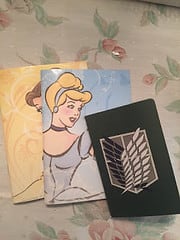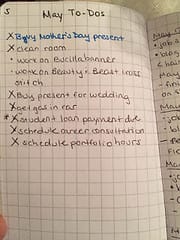One of my favorite things to collect are journals, diaries, and notebooks. I have a desk drawer full of journals I have gotten over the years. Many of these journals are still blank and waiting to be used.
Whenever I visit my local bookstore, I often visit the clearance and stationary sections just to see if there are any interesting journals I can buy. I may have a huge collection of journals, but one of the challenges I've had over the years is finding things to put in these journals. When I tried using a journal in the past, everything started just fine.
However, I eventually ran out of things to talk about and eventually stopped writing in hopes I'd find something interesting to write about when it happened. As I struggled to find things to write about, it didn't stop me from buying journals and this led to my large collection of journals. Last year, I was cleaning my room and discovered how many journals I have collected over time.
I realized then and there that I needed to find a way to better use the journals I have while finding a method that made it easier to write in my journal every day. Enter the bullet journal. I heard about this method from the BuzzFeed article WTF is a Bullet Journal and Why Should You Start One? which was featured on Facebook.
==> Click here to read the BuzzFeed article "WTF is a Bullet Journal and Why You Should Start One?"
I was still confused by the explanation but was still curious about the method. I decided to try it when one of the speakers at a Skillcrush webinar talked about it during her presentation. She encouraged participants to use this method as a way of staying organized and keeping track of tasks for freelancing or tech.
After her presentation, I sorted through my collection of journals for a journal to try and set up my journal using a video from the bullet journal website Skillcrush sent out. Below is the same video I used to set up my bullet journal and how it explains the method as well as how to set up your journal. My journal is very similar to the one in this video.
I have been using the bullet journal method for almost a year and I've gone through two journals so far. I recently started my third bullet journal and I can admit this method is everything I was looking for. I use my notebook every day and this habit has helped me stay organized while keeping me focused on what is important.
This method is still a trial by error process and I'm still changing this method to best fit my needs and lifestyle. However, the process I'm using right now is one I'm happy with and works the best for me. Today's post is all about the bullet journal method.
I'll briefly explain what a bullet journal is and show you the basics of setting up your notebook. I will walk you through each of the steps from creating your key to what needs to go in each of the logs. I'm even going to offer you suggestions on other things you can put in your journal.
What is a bullet journal?
This is often the hardest question most articles have trouble defining. This is due to the fact bullet journals can be anything you want them to be and are used differently for every person. The best definition I've seen for a bullet journal is a combination of a diary, sketchbook, and planner.
This combination creates an organization system that puts your information in one place yet it is easy to use and understand what is being put in your journal so you can understand them. That is the beauty of the bullet journal system. This system is all about customizing your journal to what works for you.
This method is great for anyone regardless of how much experience you have writing in diaries or journals. This journal is meant to grow with you and your lifestyle. Ultimately you decide what it should be like and what should be put in it.
BuzzFeed Nifty just released a video last month about bullet journals which goes into more detail than the overview video on the Bullet Journal website. This video doesn't just show you how to set up your journal, but it does a better job explaining and showing the possibilities your notebook can have.
I am not a very good artist, so I hardly use my journal as a sketchbook. I mostly use mine as a planner and occasionally as a diary. The bullet journal system is really good for helping me focus on the most important tasks I want to accomplish and keeps me on track with the goals I'm working towards.
It is a great place to keep all my ideas in one place that I can easily revisit in the future. This is the place where I keep all the ideas I want to write about for this blog, ideas for my craft shop, and even projects I want to build when I have more time.
What do you need?
This list is going to vary depending on how your journal looks. If you love to draw and doodle, you will be using a lot more than someone who just wants a simple bullet journal. Regardless of which type you are, all you need is a journal and a pen.
Many bullet journal experts and fans suggest using journals with dots or square paper since it is easier to work with and customize. However, you can use journals with lines if you like. You don't need to go crazy and buy a new notebook.
Just use whatever you have. Ryder Carroll (he's the creator of the Bullet Journal according to the Bullet Journal website) does offer a few tips to help newbies find the right journal for their systems. He suggests picking a journal that will be "rugged enough to keep up with you".
Therefore he encourages newbies to think about the size and the quality of whatever they want to use. In a nutshell, Carroll suggests journals that are similar to Moleskine or Leuchtturm. I have been using lots of journals in my collection.
This gives me a chance to try out different notebooks once I use all the pages. Right now, I am using these Disney Princess notebooks I found at the Disney Store for my journals. I just started using the Belle journal this month.
These journals have lines that I like the best since I don't do lots of doodling and sketching in my notebooks. Instead of sketching things in my journal, the notebooks already have a little bit of decoration in them. Every other page in these journals has a small image of the Disney Princess on a page.
Today's tutorial is going to walk you through the process I use to set up my bullet journals. For this post, I'm using a journal my friend got in his recent Loot Crate anime box. This notebook features a symbol from the anime Attack of the Titans.
It may be smaller than what is recommended for bullet journals, but it features square paper which is a great choice for newbies. Feel free to use whatever you like for your journal. I also use a few different color pens I got from Joann Fabrics for the key symbols.
==> Click here to learn more about Loot Crate!
==> Click here to buy the color pens I used for my bullet journal demo!
This includes stickers, images you print off the internet, colored pencils, and more. If you need more inspiration, BuzzFeed and Pinterest are great places to see what others have done with their bullet journals. The links section includes a list of great BuzzFeed articles that show other ways to customize your bullet journal.
It's time to set up your journal!
Once you have all your materials gathered together, it is time to start getting all your pages ready in your bullet journal. While bullet journals are different for every person who uses them, every bullet journal always has these pages. For today's post, I'll be showing you the following pages:
- Key of Symbols
- Index Page(s)
- Future Log
- Monthly Log
- Monthly To-Do List
- Daily Log
If any of these sections are confusing, don't forget to revisit the BuzzFeed Nifty and Bullet Journal videos. Both videos do a great job explaining and modeling all these pages. I also recommend using all the information from the Bullet Journal website. The website has lots of great tutorials, guides, and images to help newbies get their journals ready.
==> Click here to learn more from the Bullet Journal website!
Let's start with the key page.
This page can be anywhere in your bullet journal, but I like to put my key on the first page of my journal. This makes it easier for me to find when I forget a specific symbol or don't remember what a specific symbol means. My bullet journal uses the common bullet journal symbols. Below is a picture of the key in my bullet journal with all the symbols and meanings.
You don't have to use these symbols for these different tasks. Find a system that works for you, but I suggest newbies start with this system for a few weeks to see what you like and want to change. Here's a quick review of each of the meanings for the symbols in my bullet journal.
- Events mean a big event or something scheduled is happening on this date. I use these symbols often for holidays, events I'm attending, and webinar summits I plan on participating in.
- The X symbol means a task has been completed.
- The < symbol means an event has been scheduled and put in both the monthly and future logs.
- The dot lets me know I have something I need to do today while a dash is a note or reminder to myself. I use notes often to remind myself of important information.
- Finally, the > tells me a specific task needs to be migrated or completed later down the road.
The Index Page
Now that the key is set, we are almost ready to start. We need to set up the index page. I have a one-page index that lists all the page names and page numbers in my journal.
The index can be as specific as you want it to be. I like to keep mine as simple as possible by grouping all the pages for each month under the month's name in the index. Below is how my index page looks in my journal.
You won't have many pages at this point, but we'll be quickly adding pages as you move through this tutorial. As you add more pages to your journal, you will be flipping back to the index often to add each page(s). For my journal, I put the name of the page and the page number most of the time.
The only pages I group are the ones for each month. This just means the month in the index tells me where I can find the monthly log, monthly to-do list, and the month's daily log.
Future Log
The first page you can add to your index is your future log. The future log is a calendar that allows you to see all the events happening each month or over the year. I usually set up my future log for 6 months at a time.
This is where I write down important events, holidays, and important deadlines I need to remember. You can use the symbols from your key in this section, but I recommend simply writing the date and the event. For example, I wanted to remember the date for Mother's Day.
I wrote this in my future log as 24-Mother's Day in the May section. This means Mother's Day is May 24. You can be as specific as you want in your future log.
I like to add times to specific events and dates in mine. This helps me remember the important dates as I flip through my journal. I might write a dentist's appointment in my future log as 2-Dentist's Appointment 10 a.m. in May.
This helps me remember I have a dentist appointment at 10 a.m. on May 2. BuzzFeed reminds readers that they don't have to fill out their future logs right away. You can choose to fill out your future log as you go if you like. What is most important in this stage is setting up the two pages for the future log.
Monthly Log
One of the things that will help you fill out your future log is the monthly log. The monthly log lets you see everything that is happening each month. On a page, you list all the dates and abbreviations for each day of the week.
This might look like 1 M which means Monday, May 1, or 13 Sat for Saturday, May 13. Once the days and dates are written down, you just start writing down events, holidays, and scheduled tasks next to specific days. These can be special events, deadlines for payments you need to make, or when a paper for your class might be due.
Last week, I found time to schedule my first career consultation for the WordPress Developer blueprint I've been working on. When I was picking the right time to schedule, I used my monthly log to see what was happening that week. Once I scheduled a time and date, I added this information to my monthly log as "Skillcrush career consultation 4 p.m." by the date.
If I have an event scheduled for an entire week, I will block out a bunch of days for that event. For instance, I was scheduled for jury duty at the end of April. In the April monthly log, I just wrote "jury duty" next to each day I was on call for jury duty. This let me know not to plan very many things for those days in case I got put on a jury during that week.
Monthly To-Do List
BuzzFeed and Carroll group the monthly to-do list as part of the monthly log, but I'm keeping this separate since these tasks rarely appear on my monthly log. This page lists all the tasks and things you want to accomplish for every month. The to-do list is where you'll start using most of the symbols you created in your key earlier.
Take a look at my monthly to-do list for May. This list doesn't include chores I want to accomplish or deadlines I need to meet. These items can be buying a present for a special occasion or making sure I schedule specific appointments.
If any tasks need to be completed first, you can put a star next to these items on your to-do list like in this example. I recommend putting any starred items on your monthly log right away so you make sure you do these tasks right away. If I know I won't be completing a specific task that month, I will use the > next to that item so I know I can move it to the next month's to-do list.
Daily Log
We are done with the future and monthly logs, but there is one log left to do. This log is the daily log. This is where you'll be spending the most time in your journal.
The log uses rapid logging which you keep track of events, scheduled tasks, notes, and more. You don't have to put a lot of time into your bullet journal and you can do this daily log at any time you want during the day. It depends on what feels the best for you.
I don't like carrying my bullet journal everywhere I go, so I save all my rapid logging for the end of the day. I mostly write down tasks I need to do and write down notes of things that might have happened during the day or important things I need to remember. I also double-check my calendar on my phone to write down any events I've scheduled in my journal and make sure I put everything in my log.
This only takes me a few minutes every night, but you are welcome to spend more time if you would like. The daily log is going to take a lot of pages, but you can save space using a two-column layout just like the ones Carroll and BuzzFeed show in their examples. I normally can fit 12 days on a page since I don't write a lot of information for each day, but this might be different depending on your writing style, how detailed you want to be in your daily log and the kind of journal you are using.
I suggest taking 3-4 days of just rapid logging any way you want to see what your writing style is and what you like to write about. These first few days will give you a good sense of how many pages you'll be using and what layouts you might like to play around with.
What else can you add to your journal?
You have the basic pages all set up in your journal, but you don't have to just keep track of dates and events in a bullet journal. This is where most of the customization comes in. You can dedicate more pages to other things happening in your life.
These pages can be anything from lists of books you want to read to a shopping list. Anything you think about can be its separate page in your notebook. The goal of these pages is to keep similar items together and organized.
I mostly use my journal as a planner, but I have several pages set up in my notebook for different projects I'm working on or ideas I would like to remember. For example, there is a page in my journal just for ideas I would like to write about on my blog while another page is organized with all the craft ideas I want to feature in my craft shop. I even have a page just for programming which lists all the languages and skills I would like to learn next.
Conclusion
Bullet journals are a great way to stay organized and focused on the things you want to accomplish. It doesn't matter what kind of writer you are or how artistic you can be. This organization system is flexible and lets you fit the system to what works best for you.
There is no right or wrong way to do a bullet journal and chances are you'll make mistakes along the way. That is ok. You will still get the benefits no matter what.
If you want even more inspiration, I included lots of links to help you get ideas including the Bullet Journal website I mentioned frequently during this post. Lots of these articles come from BuzzFeed. They often feature content about bullet journals and how to customize your journal with different products and layouts. Feel free to check out these articles below. You can also find more ideas on Pinterest if you still want more ideas.
Links
bulletjournal.com website
The Lazy Genius Collective blog post How to Bullet Journal
Bullet Journal Facebook page
Lifehacker article on Bullet Journal
Reddit page for Bullet Journals
BuzzFeed Links
23 Genius Ways to Customizing Your Bullet Journal
16 Tips to Make 2017 Your Best Year Ever Using Just a Pencil and a Notebook
Here's How to Use a Bullet Journal for Better Mental Health
21 Tips from Normal People that Prove Bullet Journaling is for Everyone
Products Suggestions
17 Products to Help You Take Your Bullet Journal to the Next Level
17 Inexpensive Products That'll Make Your Journal Even More Awesome
Layout Ideas
25 Satisfying Bullet Journal Layouts That'll Soothe Your Soul
24 Minimalist Bullet Journal Layouts That'll Get You Hard article
21 Weirdly Soothing Bullet Journal Layouts to Try
29 Bullet Journal Layouts for Anyone Trying to Be Healthy
21 Very Merry Christmas Bullet Journal Ideas
This post was originally published on May 17, 2018 on the blog The Original BritishPandaChick. I made minor changes to the original post for DEV.










Oldest comments (1)
Loved the article! I'm looking forward to giving this a try!
I mostly just use project management software and keep track of my tasks and deadlines, I never really thought about how I should do it.
I use Quire to manage my tasks and a timer to time myself.